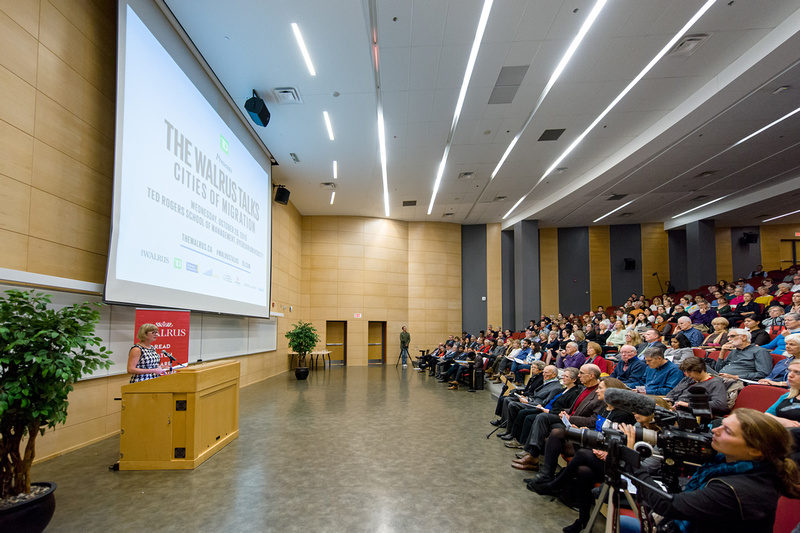
A heavy silence takes over the room as Sylvia Maracle, executive director of the Ontario Federation of Indigenous Friendship Centres, takes a pause during her seven-minute speech. “You need to make sure that when people arrive they understand that some of the trauma they have left is the trauma that exists here for the original people of this country,” she tells the audience at “The Walrus Talks Cities of Migration.” Maracle’s speech is titled “Strangers in Our Own Land,” and her soft voice grows louder as she says that when some people arrive in Canada, they are not remotely aware an indigenous population is present. “We’re asking you to make some space for the conversation.”
The Talks are one such space for conversation, often on subjects covered in the pages of The Walrus. Despite a report of tumultuous internal affairs within the editorial department of the publication, the event series runs smoothly and generates much-needed revenue to sustain the respected magazine.
With approximately 20 Talks across the country annually, and an average attendance of 400 to 450 people, the series has allowed The Walrus Foundation to move its business model away from advertising dependence. This year, the Talks generated $1.3 million, making up approximately 27 percent of the foundation’s revenue. “It is our lifeblood,” says Shelley Ambrose, publisher of the magazine. She has run the Talks with David Leonard, the foundation’s event director, since 2012.
The origins of the series date back to 2007. As a non-profit organization, The Walrus Foundation is restricted to a smaller ad revenue than mainstream commercial magazines, and when the financial slowdown hit and advertisers began pulling out, the already limited ad base became even more precarious.
The foundation turned to creating events to make up for the third of revenue that had once come from advertising (charitable donations and circulation make up the rest). Ambrose moved to create a more engaging platform that would continue to uphold The Walrus’s mission statement to “promote debate on matters vital to Canadians.”
To find the just-right way to do this, Ambrose played Goldilocks: some events were too long, some too disorganized and some too old-fashioned, boring and ineffective. “We were looking for a format that allowed for a lot of ideas with the right length of time,” she says. “Anything over 90 minutes, your bum is numb, your brain is tired, you’re thirsty and you need to pee.” A former CBC radio producer, Ambrose settled on an arrangement akin to live radio: eight speakers delivering seven-minute speeches about one broad “Walrus-y” topic—a serious issue such as resilience, water or transportation.
After Leonard joined the team in 2009, he and Ambrose set out to make sure the right conversation happened in the right city. Leonard’s aim is to generate a conversation that can continue after the event, so he curates speakers from different backgrounds. For instance, at “Cities of Migration” in Toronto, other speakers included pianist Robi Botos; Gautam Nath, a marketing expert who immigrated from India; journalist Desmond Cole; and Meb Rashid, the medical director of the Crossroads Clinic, a Toronto-based clinic that serves refugees. Then, Leonard makes sure that about 20 percent of the audience are invited guests such as business leaders, philanthropists and community leaders in culture and education. “Imagine if the head of the TTC, a social media advocate for cycling, a CEO and a community leader came together and talked about transportation,” he says. “That’s a win.”
Occasionally, the topics come together with stories in the magazine in a way that highlights the symbiotic relationship. This unity was evident at “The Walrus Talks Transportation.” “This is a perfect world,” says Ambrose. “We’re talking transportation. The magazine’s cover story is on Uber by Jon Kay. Jon Kay is a speaker tonight.” In this way, the Talks generate revenue for the magazine, but they also create content as contributors become speakers and vice versa.
Together, the Talks and the magazine attempt to profitably adapt to the way people consume information today, combining the best elements of live events, radio and social media. Consultant D.B. Scott, president of Impresa Communications Limited, says the Talks have the ability to draw subscribers to become part of the greater community and community members to become subscribers. The downside of this is that people may not want to go year after year, time after time. “They’re driven by the topic and the presenter, and maintaining a high quality of talks will be, in my opinion, a challenge,” says Scott. “There is a question as to whether there is a limit to what they’re going to be able to sustain.”
Leonard and Ambrose have already booked 21 Walrus Talks for next year. For each one, Leonard will fly to the host city, help the speakers prepare, set up the venue and live-tweet the speeches.
One constant at each event is a big red poster for The Walrus Foundation that sits next to the podium, the words Read and Watch visible from every corner of the room. The word order is inaccurate, because without the revenue generated from people watching the Talks, there would, perhaps, be no Walrus to read.
About the author
Fatima Syed is the blog editor of the spring 2016 issue of the Ryerson Review of Journalism.
